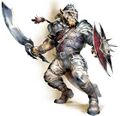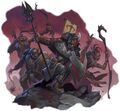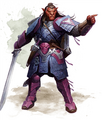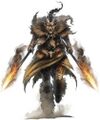Hobgoblin
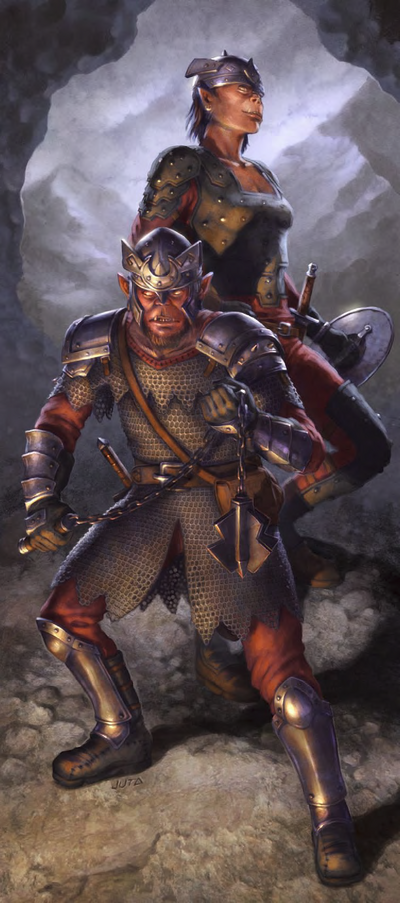
Tougher than Goblins, smarter than Bugbears, they're the Lawful Evil to Goblin's Neutral and Bugbear's Chaotic. Usually considered militaristic and malevolent, but often overlooked as cannon fodder like their smaller Goblin cousins, Hobgoblins can prove to be interesting and formidable enemies to a group of player characters, and have the capacity to be pretty badass if you want them to be. Also have a love of slavery. Physically, Hobgoblins are generally portrayed as being very large and strong, usually at least as tall as a human. They range from rust to amber in color and sometimes have blueish purple noses or ears which is kind of cool I guess.
Hobgoblins vs Orcs
If you google something like "Dungeons and Dragons Hobgoblin", you'll get a lot of results where people are asking what the real difference is between Hobgoblins and Orcs. Aren't they just the same thing with a different name and drawn slightly differently and carrying different weapons? Well, not exactly.
The short but not especially helpful answer is, to quote the Daily Bestiary blog: "Orcs may have hordes, but Hobgoblins have armies."
The longer and more expositional answer is that way back at the dawn of Dungeons and Dragons, Gary Gygax wanted to have a distinct monster with distinct stats at every early Challenge Rating (1-7). This distinction has been grandfathered in all the way down to Pathfinder and 5th Edition, though the exact differences in stats has changed over the years, and it's usually combined with the flavor portrayal - Orcs being the tribal savages, Hobgoblins being the well-organized and relentless force. Rule Zero, of course, means you can choose to use both creatures, only one, or neither, as you feel like. If your campaign is likely to travel long distances and visit vastly different regions, it can be useful to have two creatures that fill a similar niche and yet are distinct in certain ways from each other. In addition, publishers sometimes give Hobgoblins the more exotic weapons, armor, and tactics, with Advanced Dungeons & Dragons portraying hobgoblins with an almost "oriental" cast (samurai armor for the 1e version, Mongolian clothes for the 2e), which is something that Pathfinder preserved.
For those of you who follow Tolkien, the traits of the Lord of the Rings Orcs were actually split between Dungeons and Dragons' Orcs and Hobgoblins. D&D Orcs are reminiscent of the cave-dwelling ambushers Bilbo met in the Misty Mountains or the hordes that Sauron used to attack Gondor, while D&D Hobgoblins are more like Saruman's Uruk-hai.
Perhaps to try and reinforce the split, unlike orcs, hobgoblins are usually not suggested to be capable of interbreeding with other races... at least, not since thouls stopped being a thing. But, the Kingdoms of Kalamar setting for 3rd edition decided to just say "fuck it" to that noise, introducing the Sil-karg, or Half-Hobgoblin, to go alongside the Half-Orc.
Hobgoblins, the Playable?
As it turns out, that natural lawfulness means that when you get down to it, hobgoblins are a pretty decent option for monster adventurers. After all, if they're not as murderously self-interested as standard Chaotic Evil monsters, then logicially they can find common cause to adventure with humanoids for whatever reasons.
In fact, Hobgoblins have actually been playable in literally every single edition of D&D, from Basic through to 5th.
Basic
Basic D&D presented Hobgoblins as a PC race in the 10th of the Known World Gazetteers, which makes sense if you're aware that Gazetteer #10 was "The Orcs of Thar". Hobgoblins received the following traits:
- Hobgoblin Ability Modifiers: +1 Strength, -1 Dexterity
- Note: Like all Humanoids from "The Orcs of Thar", a Hobgoblin has racial ability score caps of 18 in all scores bar Intelligence and Wisdom, which are capped at 16.
- Note: Like all Humanoids from "The Orcs of Thar", a Hobgoblin determines its Charisma score for interacting with humans and demihumans by dividing its Charisma score by 3 (rounding down) and subtacting the result from 9.
- Hobgoblin Natural Armor Class: 8
- Can become Shamans (8th level) and Wokani (4th level).
| Hobgoblin's's level | XP Required | Hobgoblin's hit dice |
|---|---|---|
| 0 | 0 | d8+1 |
| 1 | 1,200 | 2d8+2 |
| 2 | 2,400 | 3d8+3 |
| 3 | 4,800 | - |
| 4 | 9,600 | 4d8+4 |
| 5 | 19,000 | 5d8+5 |
| 6 | 38,000 | 6d8+5 |
| 7 | 76,000 | - |
| 8 | 150,000 | 7d8+5 |
| 9 | 300,000 | +2 Hit Points |
| Subsequent | 240,000 | +2 Hit Points |
Advanced
In AD&D, hobgoblins were naturally added in the Complete Book of Humanoids, along with most other savage humanoids like orcs, goblins, gnolls and ogres.
- Ability Modifiers: -1 Charisma
- Ability Mins/Maxs: STR 6/18, DEX 6/18, CON 5/18, INT 3/18, WIS 3/18, CHA 3/14
- Available Classes: Fighter (11), Cleric (9), Shaman (7), Witch Doctor (7), Thief (12)
- Natural Armor Class: 10
- Hit Dice: By class
- Infravision 60 feet
- 40% chance to detect new construction, sloping passages, and shifting walls when within underground complexes (roll 1d10; the hobgoblin senses these features on a 1-4).
- Dwarves receive a +1 bonus to attack rolls vs. hobgoblins.
- Weapon Proficiencies: Long Composite Bow, Morning Star, Scimtar, Spear, Whip, Pole Arms
- Nonweapon Proficiencies: Armorer, Blacksmithing, Bowyer/Fletcher, Brewing, Chanting, Close-Quarter Fighting, Direction Sense, Fire-Building, Hiding, Intimidation, Looting, Religion, Weaponsmithing, Wild Fighting
3rd Edition
Hobgoblin PC stats were actually all over the place in 3rd edition! First appearing in the Monster Manual, they were then reprinted in the Races of Ansalon and Faerun, remaining identical in every printing:
- +2 Dexterity, +2 Constitution
- Base land speed 30 feet
- Darkvision 60 feet
- +4 racial bonus on Move Silently
- Favored Class: Fighter
- Level Adjustment: +1
You may wonder just why it is that they get a +1 LA rating? Well, the truth is it's because... Level Adjustment was a stupid idea, really. It was just pretty poorly handled all around. For the first half of 3.5 Wizards of the Coast generally failed to realize that ability scores that weren't net zero (or worse) aren't all that powerful, especially compared to a human's free feat.
In Kingdoms of Kalamar, hobgoblins lost the +1 LA at the cost of suffering a -2 penalty to Int, Wis and Cha. Even with their +2 to Listen & Spot checks, way underpowered.
In Eberron Hobgoblins were one of the great empires of the past and have a sovereign, recognized, nation plus a history of mercenary work. While not exactly respected in most of Eberron, including one in an adventuring party is perfectly plausible.
4th Edition
Hobgoblins appeared in 4e's 1st Monster Manual, alongside many other iconic monstrous races. They weren't particularly exciting when they did, but they were functional and certainly not as badly off as in some editions:
- Ability Scores: +2 Constitution, +2 Charisma
- Size: Medium
- Speed: 6 squares
- Vision: Low-Light
- Skill Bonuses: +2 Athletics, +2 History
- Battle Ready: +2 bonus to Initiative checks
- Racial Power - Hobgoblin Resilience: Once per encounter, as an immediate reaction to being affected by an effect that a save can end, you can make a save to end that effect.
4th edition would later present them as a Winning Races article in Dragon Magazine #419. In this version, their ability modifiers were +2 Con and +2 to Cha or Int, they gained the Phalanx Soldier racial trait (+1 to AC if you are wielding a shield and standing adjacent to a shield-wielding ally), and Hobgoblin Resilience was replaced with Hobgoblin Discipline (1/encounter, as a free action, immediately end an ongoing save-ends effect at the start of your turn).
5th Edition
Nasty mid-level monsters. Low hitpoints, but good armor for monsters and have a faux-sneak attack that deals a shitload of extra damage when they focus-fire on a single target, which they will get off because your brain-dead party couldn't focus-fire on the squishy-but-deadly guys if their lives literally depended on it, right? Volo's Guide to Monsters added brutal monk/cops that can turn invisible and powerful blaster wizards that get faux-evoker powers and can apply that faux-sneak attack to all of their spells. Even the AoEs.
Added as a playable race in in Volo's Guide to Monsters, along with both the other goblinoids. +2 Con, +1 Int, proficiency in light armor and some weapons of the player's choice, and the ability to "save face" by re-rolling a failed d20 roll with a bonus equal to the number of allies watching (+5 tops) rather than their iconic "monster power". Mockingly described as being all wizards, since Int bonuses are scarce and getting additional weapons and armor is a lot better for classes that don't already get them, but a Con bonus is welcome in any class.
Golarion Hobgoblins
On the world of Golarion, hobgoblins are the result of an ancient attempt at fleshcrafting ordinary goblins into bigger, stronger and smarter forms that could then be used as expendable soldiers to defeat the elves. Whilst the elves managed to stop their creators before they could install controls, but not in time to keep them from hating elves instinctively or from seeking to conquer and destroy. Nice going, pointy-ears. Since they hate elves, they hate arcane magic and even Sorcerers are unheard of among them. They make up for this with Alchemists, Ja Noi allies, the occasional devil worshiping shaman Cleric and engineers (the kind that makes mundane siege engines and fortifications rather than steampunk).
Golarion hobgoblins are most notable because they're supposed to be completely hairless... but, as Paizo began using them more frequently, hobgoblins with hair became increasingly common in their artwork. Rather than admit that this was just a result of different artists ignoring that lore, Paizo retconned that Golarion hobgobs are hairless... but scalp humanoid foes they defeat and make wigs out of their hair, which they wear as symbols of prowess and honor.
Their stats are unchanged from 3E, except they lose level adjustment and, per Pathfinder's changes to the skill system, their move silently bonus is now a bonus to Stealth. They have options to trade away this bonus for a few things, and one thing to trade their darkvision for, but in the end the only reason to bother with playing one is they alone have the perfect ability scores for a Kineticist.
Monstergirls?
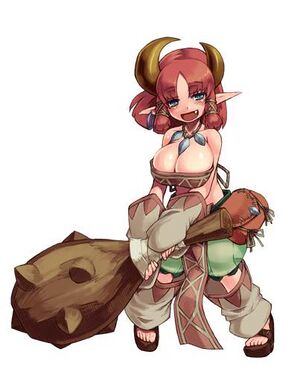
Because hobgoblins are not readily distinguished from goblins in the eyes of most people, the idea of a hobgoblin monstergirl is an uncommon one at best. Perhaps the most believable depiction of a hobgoblin MG would be as a race of goblinoid amazons; curvy female goblinoids who use force to secure what they want, be it land, wealth, or a human boytoy.
For what it's worth, there is one D&D adventure where a sexy female hobgoblin appears; Red Hand of Doom features Wyrmlord Ulwai Stormcaller, a female hobgoblin stormsinger whose rare blue eyes and uncanny good looks have attracted much torment for her throughout her life, as other hobgoblins have accused her of being half-human, or even half-elven. The same description also calls her a masterful liar even though she has no ranks in bluff and her art is pretty far from sexy, so take the description with some skepticism.
In the Monster Girl Encyclopedia, hobgoblins are portrayed as ditzy, dim-witted, clumsy oppai loli variants of the common goblin; despite being even dumber than their flat-chested sisters, goblins adore and revere them, seeing their huge breasts as a sign of great power and potential. Perhaps because hobgoblin mamono are even more ridiculously super-strong than the goblins are themselves; they may not have much going for them, but if they hit you, then you stay hit. Or else it's because the common goblins are smart enough to realize that breasts are a huge advantage in terms of having fun whilst having sex.
-
They're over here....
-
...And they're over there...
-
...Those Darn Hobgoblins are everywhere!
Gallery
-
First edition hobgoblin art.
-
DiTerlizzi art from the 2e Monstrous Manual.
-
Finalized 3rd edition artwork.
-
A troop of hobgoblins from the Nentir Vale.
-
The infamously lion-faced hobgoblin of 5th edition .
-
A Hobgoblin Firebrand from the Pathfinder RPG
-
An Oriental style Hobgoblin commander, also from Pathfinder
-
If anything, Hobgoblins can make some pretty good beer.
| Dungeons & Dragons 1st Edition Races | |
|---|---|
| Basic Set | Dwarf • Elf • Hobbit • Human |
| Creature Crucible 1 | Brownie • Centaur • Dryad • Faun • Hsiao • Leprechaun • Pixie • Pooka • Redcap • Sidhe • Sprite • Treant • Wood Imp • Wooddrake |
| Creature Crucible 2 | Faenare • Gnome • Gremlin • Harpy • Nagpa • Pegataur • Sphinx • Tabi |
| Creature Crucible 3 | Kna • Kopru • Merrow • Nixie • Sea Giant • Shark-kin • Triton |
| Dragon Magazine | Cayma • Gatorman • Lupin • N'djatwa • Phanaton • Rakasta • Shazak • Wallara |
| Hollow World | Beastman • Brute-Man • Hutaakan • Krugel Orc • Kubitt • Malpheggi Lizard Man |
| Known World | Bugbear • Goblin • Gnoll • Hobgoblin • Kobold • Ogre • Troll |
| Dungeons & Dragons 2nd Edition Races | |
|---|---|
| Core | Dwarf • Elf • Gnome • Half-Elf • Half-Orc • Halfling • Human |
| Dark Sun | Aarakocra • Half-Giant • Mul • Pterran • Thri-kreen |
| Dragonlance | Draconian • Irda • Kender • Minotaur |
| Mystara | Aranea • Ee'ar • Enduk • Lizardfolk (Cayma • Gurrash • Shazak) • Lupin • Manscorpion • Phanaton • Rakasta • Tortle • Wallara |
| Oriental Adventures | Korobokuru • Hengeyokai • Spirit Folk |
| Planescape | Aasimar • Bariaur • Genasi • Githyanki • Githzerai • Modron • Tiefling |
| Spelljammer | Dracon • Giff • Grommam • Hadozee • Hurwaeti • Rastipede • Scro • Xixchil |
| Ravenloft: | Broken One • Flesh Golem • Half-Vistani • Therianthrope |
| Complete Book Series | Alaghi • Beastman • Bugbear • Bullywug • Centaur • Duergar • Fremlin • Firbolg • Flind • Gnoll • Goblin • Half-Ogre • Hobgoblin • Kobold • Mongrelfolk • Ogre • Ogre Mage • Orc • Pixie • Satyr • Saurial • Svirfneblin • Swanmay • Voadkyn • Wemic |
| Dragon Magazine | Half-Dryad • Half-Satyr • Uldra • Xvart |
| Dungeons & Dragons 4th Edition Races | |
|---|---|
| Player's Handbook 1 | Dragonborn • Dwarf • Eladrin • Elf • Half-Elf • Halfling • Human • Tiefling |
| Player's Handbook 2 | Deva • Gnome • Goliath • Half-Orc • Shifter |
| Player's Handbook 3 | Githzerai • Minotaur • Shardmind • Wilden |
| Monster Manual 1: | Bugbear • Doppelganger • Githyanki • Goblin • Hobgoblin • Kobold • Orc |
| Monster Manual 2 | Bullywug • Duergar • Kenku |
| Dragon Magazine | Gnoll • Shadar-kai |
| Heroes of Shadow | Revenant • Shade • Vryloka |
| Heroes of the Feywild | Hamadryad • Pixie • Satyr |
| Eberron's Player's Guide | Changeling • Kalashtar • Warforged |
| The Manual of the Planes | Bladeling |
| Dark Sun Campaign Setting | Mul • Thri-kreen |
| Forgotten Realms Player's Guide | Drow • Genasi |
| The Races of Pathfinder | |
|---|---|
| Player's Handbook: | Dwarf - Elf - Gnome - Half-Elf - Half-Orc - Halfling - Human |
| Advanced Race Guide: |
Aasimar - Catfolk - Changeling - Dhampir - Duergar Drow - Fetchling - Gillman - Goblin - Grippli - Hobgoblin Ifrit - Kitsune - Kobold - Merfolk - Nagaji - Orc - Oread Ratfolk - Samsaran - Strix - Suli - Svirfneblin - Sylph Tengu - Tiefling - Undine - Vanara - Vishkanya - Wayang |
| Bestiaries: | Android - Astomoi - Caligni - Deep One Hybrid - Gathlain Gnoll - Kasatha - Munavri - Naiad - Orang-Pendak Reptoid - Rougarou - Shabti - Trox - Yaddithian |
| Adventure Paths: | Being of Ib - Kuru |
| Inner Sea Races: | Ghoran - Monkey Goblin - Lashunta - Skinwalker Syrinx - Triaxian - Wyrwood - Wyvaran |
| Ultimate Wilderness: | Vine Leshy |
| Blood of the Sea: | Adaro - Cecaelia - Grindylow - Locathah - Sahuagin - Triton |
| Planar Adventures: | Aphorite - Duskwalker - Ganzi |





